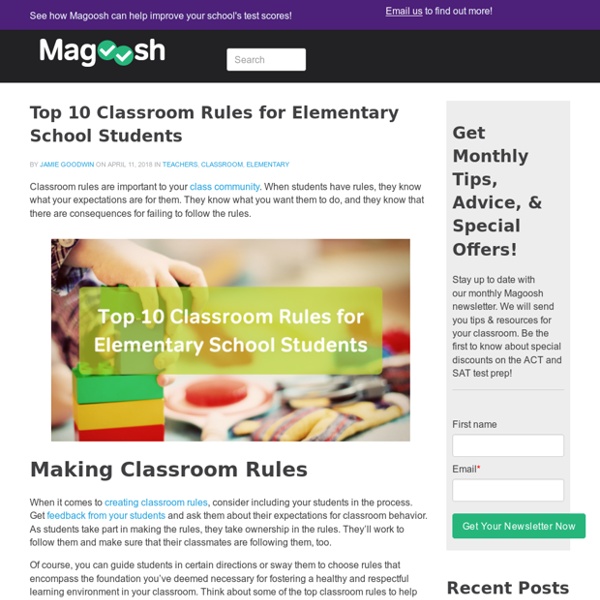Establishing Classroom Rules
By Phil Nast, retired middle school teacher and freelance writer Found In: Classroom Management Appropriate behavior fosters a positive classroom environment. Engaging students on the first day of school in creating of a set of rules helps ensure their investment. The following professional development resources, articles, and activities offer different approaches to this common start of school task. Professional Development
20 Classroom Management Strategies
Paper airplanes fly across the room. Students race between desks. You can’t get a word in, as they yell over you. It doesn’t have to be this dramatic, like a movie scene you’d watch in a media literacy lesson, but poor classroom management will almost assuredly elevate your stress and burnout rates.
List of Classroom Rules
Establishing a set of classroom rules on your first day back to school will set the tone for a productive new school year. Pick 5-10 classroom rules from the big list below that would best fit your students. Write down your main classroom rules on a chart and hang the rules in a highly visible area of the classroom.
Classroom Rules- Elementary Level
Class Rules Set #1 No interfering with the teaching and learning of others.Respect personal space, rights and property of others.Follow directions of all your teachers.Come to class prepared with all supplies and homework complete. Class Rules Set #2 Be respectful of yourself and others.
Elementary Vocabulary Words
Teaching vocabulary to elementary students is one way to improve their reading comprehension and fluency. When many children come across an unfamiliar vocabulary word in a text, they often struggle to decode it and lose the rhythm of the passage. If this is the case for your child, check out the following online vocabulary resources. The 'Basic Vocabulary List' from Reading Rockets Reading Rockets is a national resource designed to encourage elementary kids to read and help parents and educators implement effective strategies.
Blog Hoppin': Teacher Week: My Classroom Digs
Hey all! Welcome to Day 2 of Blog Hoppin’s Teacher Week! Today is all about WHERE you teach- we want to see your classroom digs! I don’t know about you but my classroom was always my “home away from home.”
Top Proven Classroom Management Tips - Elementary Education Degree
Teaching is tough job, no doubt about it. And working with young children can be a little overwhelming at times, especially when class sizes are large. But many seasoned educators have a sixth sense when it comes to classroom management—what works and what doesn’t—and thankfully, many of their strategies are available on the web and in print to help other teachers achieve the same success. So check out our list of proven tips to help you manage your classroom more efficiently and effectively. Tip #1: Establish classroom rules immediately and enforce them consistently. Establish rules on the first day of class, and always follow through on the specified rewards for achievement and consequences for misbehavior.
Why I Don’t Have Classroom Rules
However, while I was clearing my credential, working with mentor teachers to reflect on my practice, and finding out how real students differed from theoretical ones, I also spent long hours after school with the speech and debate team reading philosophy and theory and talking about innovative alternatives for national defense, natural resource allocation, and, of course, education. That led me to some uncomfortable conclusions. Although I encouraged my students to think critically and challenged myself to develop new methods of instruction, the actual conduct of the class seemed at odds with all that. I wanted my students to do more than just follow rules handed down to them.
Everyday Rules That Work!
Scholastic published this article on the Responsive Classroom approach to rules and logical consequences for the August 2003 issue of Instructor magazine. It was reprinted with permission on the Responsive Classroom website, September 2003. Kathryn Brady, Mary Beth Forton, Deborah Porter, and Chip Wood are the authors of Rules in School, from which this article was adapted. Model the Behavior You Want to See From the first day, lay the foundation for a successful year by letting students know what behavior you expect. Modeling classroom routines takes time, but it’s time well spent!
Fluency Practice Passages
Why Use Fluency Practice Passages Fluency is a key foundational skill that helps students read complex text with greater understanding. When students read with accuracy and expression at an appropriate reading rate, their fluency supports their comprehension. Repeated reading practice with short passages improves word recognition and automaticity. How to Use Fluency Practice Passages
Effective Classroom Management for Elementary Students: Styles and Techniques Effective Elementary Classroom Management
One can only tell that classroom management styles and techniques are effective if he applied it in the classroom and were proven to be effective. Application of the theory in a real life situation is the best reference to determine whether the styles and techniques used were truly effective. I have been in the elementary classroom for quite a time and I've tried different styles and techniques to manage my class. I can tell that teaching is a very stressful job but so rewarding when you see the result of your efforts.
Classroom Management Strategies: The Ultimate List – Proud to be Primary
This post contains affiliate links for your convenience. As an Amazon Associate I earn from qualifying purchases. View disclosure policy HERE.



